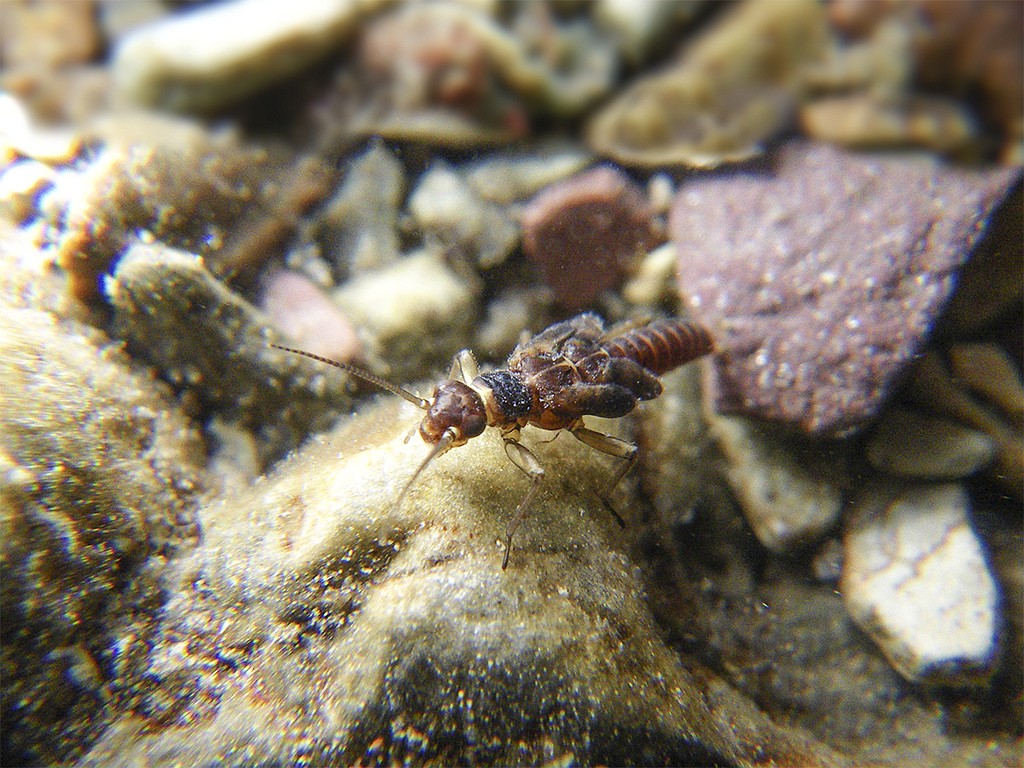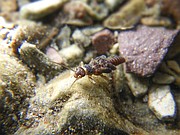Study: Rare aquatic species can adapt to glacier melt
When looking at side-by-side photos of Sperry Glacier in 1949 and more recently in 2015 — two images used as supporting documents in a recently completed study — even those who may not consider themselves science-savvy can recognize the stark difference between the pictures.
A significant portion of the glacier has melted away, exposing large swaths of earth that had previously spent centuries beneath ice. And while a once-formidable glacier disappearing is perhaps a more obvious example of one of the side-effects of a warming planet, it’s the tiny creatures thought to be glacier-dependent that are the subjects of a 10-year study recently published in the prestigious Proceedings of the National Academy of Sciences.
This spring, a sizable team of researchers with University of Montana’s Flathead Lake Biological Station and the U.S. Geological Survey (USGS) completed their study on how the retreat of glaciers in Glacier National Park influence the rare cold-water species that rely on meltwater. The research was spearheaded by Clint Muhlfeld, a research ecologist and associate professor with USGS and the bio station, and it was co-authored by Timothy Cline, an ecologist with USGS.
According to Muhlfeld, the primary goal of the study was to test the widespread prediction that shrinking glaciers will reduce biodiversity in rugged, mountainous ecosystems. But what Muhlfeld and his team discovered was various cold-water invertebrates, such as the Endangered Species Act-protected Meltwater Lednian Stonefly, have unexpectedly persisted despite the shrinkage of glaciers.
“What we discovered is there is hope for long-term aquatic biodiversity in these high-elevation areas,” Muhlfeld said. “It’s a common thought that many of these species are reliant on glacier melt specifically, but we also found them in groundwater springs and snowmelt areas — in spaces that are essentially now devoid of glaciers. While they may not exist in as large of quantities in these warmer areas as they do in the colder ones, they still have managed to sruvive.”
The study is the first of its kind, Muhlfeld said.
He explained that while the vanishing of glaciers is a global phenomenon and is something that has been researched for decades by many, no one to his knowledge has looked at the side-effects of this on specific cold-water species in regions as mountainous as those found in the park.
“Glaciers like these and some of these species don’t exist anywhere else in the world at these elevations,” Muhlfeld said. “We spent a significant amount of time in some of the most remote areas in the park. Many of these areas have never been sampled before and it sometimes took us days just to reach a site.”
The team quantitatively sampled a wide range of alpine species at 129 sites along 58 streams in the park ranging in elevations from 1,474 to 2,431 meters. Each of the sites also had varying levels of glacial influence, meaning some samples came from waters at the literal base of a glacier and others came from streams fed purely by snowmelt or groundwater.
This extensive data was then combined with high-resolution glacier retreat imagery and data from the end of the Little Ice Age in 1850 through 2015 in order to test whether glacier retreat had actually reduced biodiversity in the park through the loss of uniquely adapted meltwater species.
In other words, do meltwater stoneflies and other cold-water species still exist in areas where glaciers once stood nearly 170 years ago? And the answer is yes, but according to Muhlfeld, right now - given current research - there is uncertainty as to how long they will survive and in what quantities.
AS ANOTHER portion of the study, Muhlfeld and his team wanted to gauge just how much glacier loss can occur before there is a significant decline in these species as well.
According to the study, Glacier National Park contained 146 glaciers at the end of the Little Ice Age. However, only 35% of those glaciers persisted through 2005 and “complete deglaciation” is predicted by 2100, given current warming trends. Taking this into consideration, the study predicts a 70% to 80% decline in “suitable habitat” for these cold-water invertebrates by the end of the century.
While this does not necessarily mean the species will completely disappear — as the study has shown they survive in groundwater springs and snowmelt catchments as well — Muhlfeld said there may come a day when they can no longer adapt.
“Glaciers are rapidly disappearing worldwide and these high-elevation mountain landscapes, which are home some of the harshest landscapes in the world, are hotspots for biodiversity. But the landscapes are changing at a rapid rate,” Muhlfeld said.
He explained that although these species have been detected in warmer waters, many of them have slowly moved higher and higher upstream in search of cooler meltwater over the decades. But the species that are not confined to a pool of sorts and are able to journey to colder waters at higher elevations, have reached their climbing limits.
“These species have been tracking these glaciers for decades and now there’s really nowhere else to go,” Muhlfeld said. “It’s squeeze play at the top of the mountain. This region is quite literally the water tower of North America and we need to be sure we are conserving and perserving these areas.”
Muhlfeld said in order to accurately depict how the meltwater stonefly and other species fare into the future, much more research will need to be performed and more data will need to be gathered. And while he said this study is something to be celebrated, he hopes it can be used as more of a jumping-off point for additional research.
As is highlighted in the conclusion of the study, “climate change impacts on mountain biodiversity remain complex and uncertain.” It continues, “More work is needed to understand how different dimensions of ecological diversity (e.g., habitat variation, genetic diversity, locally adapted communities) are affected by climate-induced glacier loss in high-elevation mountain ecosystems. Conservation of mountain biodiversity with climate change will require protecting high-elevation landscapes, while addressing the root causes of global warming.”
Reporter Kianna Gardner can be reached at 758-4407 or kgardner@daliyinterlake.com




